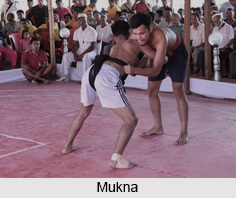 A form of folk wrestling, the sport of Mukna is highly popular in the Indian state of Manipur. It is a combination of wrestling and judo and is most popular in the areas of Imphal, Thoubal and Bishnupur. Known to be one of the indigenous sports in Manipur, Mukna is played on the last day of the Lai Haraoba festival and is an intrinsic part of the ceremonial functions.
A form of folk wrestling, the sport of Mukna is highly popular in the Indian state of Manipur. It is a combination of wrestling and judo and is most popular in the areas of Imphal, Thoubal and Bishnupur. Known to be one of the indigenous sports in Manipur, Mukna is played on the last day of the Lai Haraoba festival and is an intrinsic part of the ceremonial functions.
History of Mukna
According to historical records, the existence of Mukna has been mentioned since the 15th century. It is believed that in Manipur the Mukna type of wrestling has been around since the Satya Yuga, when the sons of Atiya Guru Shidaba, Pakhangba and his brother Sanamahi, who was the incarnation of a horse, wrestled over the throne. During the fight, Pakhangba had held Sanamahi in a deadly grip that rendered him powerless and this paved the way for the birth of Mukna. In the later years, the sport of Mukna mainly flourished during the reign of King Khagemba.
Techniques of Mukna
It is said that the techniques used in Mukna are similar to other forms of martial arts like Pehlwani, which is the ancient South Asian style of wrestling. The grappling technique called "lou" is used in this sport and is known to be a common aspect in a variety of other wrestling martial arts. The contestants are paired according to their weight class and are required to have absolute physical fitness and skill to master the technique of "lou". Certain moves such as striking the opponent or holding their neck, hair, ear or legs are not permitted. The main object of the game is to pin the opponent on their back touching the ground.
Some of the primary moves that are used by the contestants when competing in Mukna are the hip throw or "ningong", which is twisting the opponent"s calf in order to render them helpless. This move is also known as "longkhrou". Lastly, there is the high throw or "khudong", where an opponent is thrown off their balance of a high ground.
Overview of Mukna
The contestants participating in Mukna wear some of the traditional equipment and dresses of the land. This is primarily done to protect the vital parts of a player`s body. It also helps to identify the "pana" or the "yek", to which the wrestler belongs. The waist belt is known as a "ningri", to which the competitors hold each other, thus marking the beginning of the sport. And the winner of Mukna is called a "yatra".






